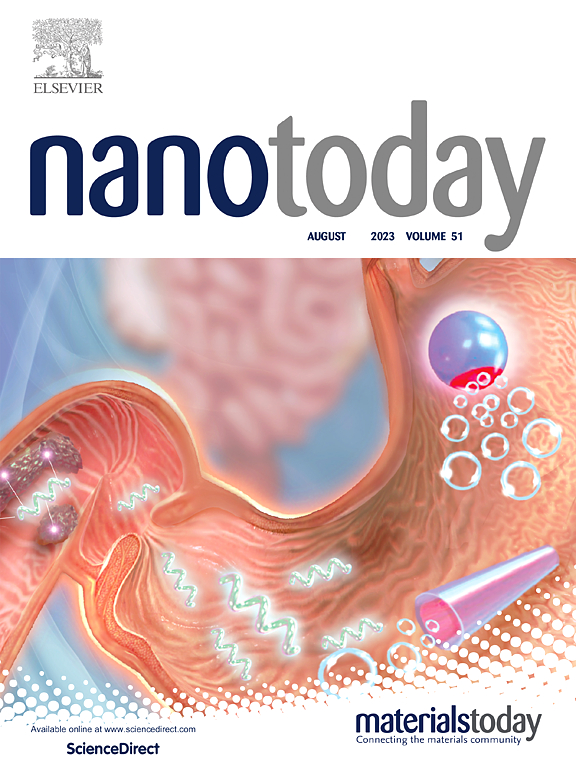Tetrahedral DNA nanostructure based siRNA delivery vehicle for braf gene silencing and MEK-ERK pathway inhibition in the treatment of refractory thyroid cancer
IF 13.2
1区 材料科学
Q1 CHEMISTRY, MULTIDISCIPLINARY
引用次数: 0
Abstract
The BRAF V600E mutation induces sustained activation of the MEK-ERK signaling pathway, driving accelerated cell proliferation, enhanced migration, invasion, and resistance to apoptosis, which is recognized as a critical pathogenetic mechanism in refractory thyroid cancer. Small interfering RNA (siRNA) holds significant promise in cancer therapy due to its high specificity and silencing efficiency, ease of synthesis, and cost-effectiveness. However, its clinical application is limited by poor permeability and stability. DNA-assembled nanostructures, especially the tetrahedral DNA nanostructures (TDNs), are promising nanocarriers with preeminent biosafety, low biotoxicity, and high transport efficiency. In this study, we therefore synthesized a TDN-based BRAF V600E-siRNA delivery system (TDN-siBraf), which not only prolonged the half-life of siRNA, but also exhibited efficient siRNA delivery, excellent biocompatibility, and gene silencing efficiency. By establishing two distinct cell line models, a murine model and a notable in vitro patient-derived tumor organoids (PDTOs) model of refractory thyroid cancer, we demonstrated that TDN-siBraf could enhance targeted siBraf delivery and improve antitumor efficacy both in vivo and in vitro by inhibiting cancer cell proliferation and invasion while promoting apoptosis, with favorable biosafety and biocompatibility. Furthermore, treatment with the TDN-siBraf effectively inhibited the activation of the MEK-ERK signaling pathway, leading to mitochondrial dysfunction and elevated DNA damage, which ultimately culminated in cellular impairment. This study introduces a high-efficiency TDN-siBraf delivery system with prolonged siRNA half-life and enhanced antitumor activity in refractory thyroid cancer, offering a promising strategy with significant clinical translation potential.
基于四面体DNA纳米结构的siRNA递送载体,用于治疗难治性甲状腺癌中的braf基因沉默和MEK-ERK通路抑制作用
BRAF V600E突变诱导MEK-ERK信号通路持续激活,加速细胞增殖,增强迁移、侵袭和对凋亡的抵抗,这是公认的难治性甲状腺癌的重要发病机制。小干扰RNA (Small interfering RNA, siRNA)因其高特异性和沉默效率、易于合成和成本效益而在癌症治疗中具有重要的前景。但其渗透性和稳定性较差,限制了其临床应用。DNA组装纳米结构,特别是四面体DNA纳米结构(tdn)是一种极具生物安全性、低生物毒性和高运输效率的纳米载体。因此,在本研究中,我们合成了一种基于tdn的BRAF V600E-siRNA递送系统(TDN-siBraf),该系统不仅延长了siRNA的半衰期,而且具有高效的siRNA递送、优异的生物相容性和基因沉默效率。通过建立两种不同的细胞系模型,小鼠模型和显著的体外患者源性肿瘤类器官(PDTOs)模型,我们证明了TDN-siBraf可以通过抑制癌细胞的增殖和侵袭,促进细胞凋亡,增强siBraf的靶向递送,提高体内和体外的抗肿瘤疗效,具有良好的生物安全性和生物相容性。此外,TDN-siBraf治疗有效抑制了MEK-ERK信号通路的激活,导致线粒体功能障碍和DNA损伤升高,最终导致细胞损伤。本研究介绍了一种高效的TDN-siBraf递送系统,该系统具有延长siRNA半衰期和增强抗肿瘤活性的特点,为难治性甲状腺癌提供了一种具有重要临床转化潜力的有前途的策略。
本文章由计算机程序翻译,如有差异,请以英文原文为准。
求助全文
约1分钟内获得全文
求助全文
来源期刊

Nano Today
工程技术-材料科学:综合
CiteScore
21.50
自引率
3.40%
发文量
305
审稿时长
40 days
期刊介绍:
Nano Today is a journal dedicated to publishing influential and innovative work in the field of nanoscience and technology. It covers a wide range of subject areas including biomaterials, materials chemistry, materials science, chemistry, bioengineering, biochemistry, genetics and molecular biology, engineering, and nanotechnology. The journal considers articles that inform readers about the latest research, breakthroughs, and topical issues in these fields. It provides comprehensive coverage through a mixture of peer-reviewed articles, research news, and information on key developments. Nano Today is abstracted and indexed in Science Citation Index, Ei Compendex, Embase, Scopus, and INSPEC.
 求助内容:
求助内容: 应助结果提醒方式:
应助结果提醒方式:


